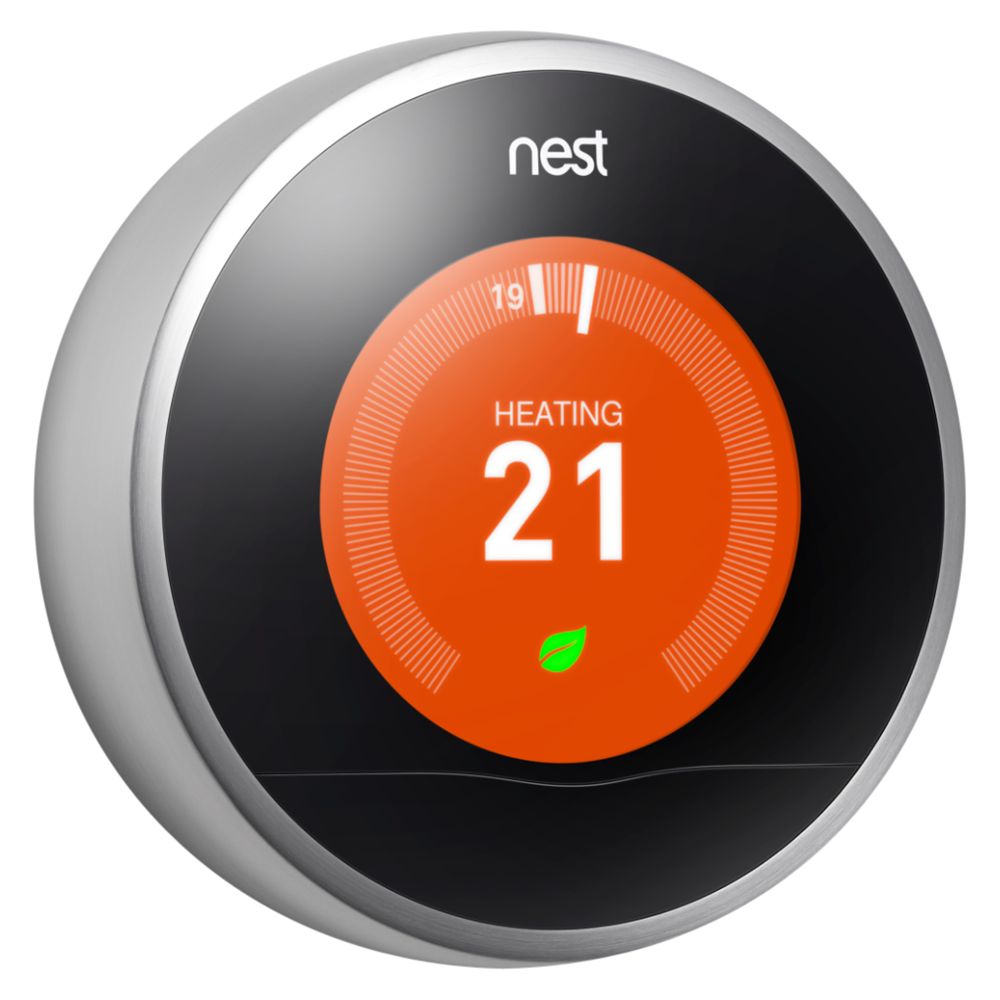Buying Guides

Buying Energy Efficient Appliances
When you buy a new home appliance, consider how its running costs can help you save on energy bills. Improvements and innovation in energy efficiency mean you can get the best out of your machine and your budget.
This guide will show you what energy efficiency features to look out for when buying your next appliance
If you're buying a dishwashing, refrigeration or laundry appliance, check out our YourEko tool. Designed to help you make informed decisions, it highlights the life-time running costs of your machine.
Energy labels
Energy labels have been around for over 25 years, helping you choose products that can save money on running costs and reduce energy consumption.
Regulations require an energy label to be displayed on certain electrical goods. Each label provides an energy rating for the appliance as well as relevant information on how much water or electricity it uses and how much noise it creates.
The energy labelling system changed iin 2021 and the newer labels will be included when you buy:
- household refrigerators and freezers
- washing machines and washer dryers
- dishwashers
- TVs and electronic displays
- lighting products (from September 2021)
Other products like air conditioners, tumble dryers, space and water heaters will have the new labels introduced when new or revised UK regulations come into force.
Ovens and cookers will not be included in the new rating scale.
The simplified label encourages better technology
The new rating on appliances may be lower in comparison to the old rating scale, but it’s simply been recalibrated to make room for further improvements in energy efficiency.
Appliance and lighting manufacturers have been developing better technology since the labels were introduced in 1994. With over 90% of today’s products being rated A+++, the system of pluses could no longer show advancements clearly as newer products were released.
Not only does the updated scale make it simpler to understand a product’s energy consumption, it also encourages manufacturers to continue building more efficient appliances to save resources and the environment.
Most of the products we sell have had an A rating or higher on the old rating system, and we will continue to stock the best appliances for energy efficiency as they come onto the market. If you bought an appliance between June 2020 and March 2021, both the old and updated labels were included in the packaging.
Electricity usage
A major step towards your household becoming more energy efficient is identifying what items are using the most electricity.
You can purchase an electricity monitor that lets you see how much energy is being consumed and where. You can then review how often you use particular machines and set energy caps or targets. An energy monitor is different from a smart meter, which sends information about your energy usage to your energy provider.
As part of our Smart home range, you can buy a thermostat that can be controlled from your smartphone at home or on the go. With devices from Nest and Hive you’ll see how much heat you use every day so you can track and manage your energy use. With some brands you can also track and control your lighting, hot water and other appliances.
Energy efficient refrigerators, freezers and fridge freezers
Refrigeration appliances are one of the biggest energy consumers in your home because they are left running all the time. This makes investing in an energy-efficient fridge, freezer or fridge even more viable because it can help cut your energy bills. For example, some brands feature a holiday mode, which uses less energy to maintain the internal temperature.
Even features in aid in food safety, such as bespoke systems
that ensure food maintains its freshness for longer, ultimately save you money as you won’t be buying food as often.
The labels show information on storage volume (in litres), frozen storage volume (in litres) and noise level (in decibels).
How to read the refrigeration energy label:
1 - Energy efficiency scale
2 / 3 - Icon for chilled and unfrozen compartments
4 - Icon for noise emissions and more detail of noise emission classes
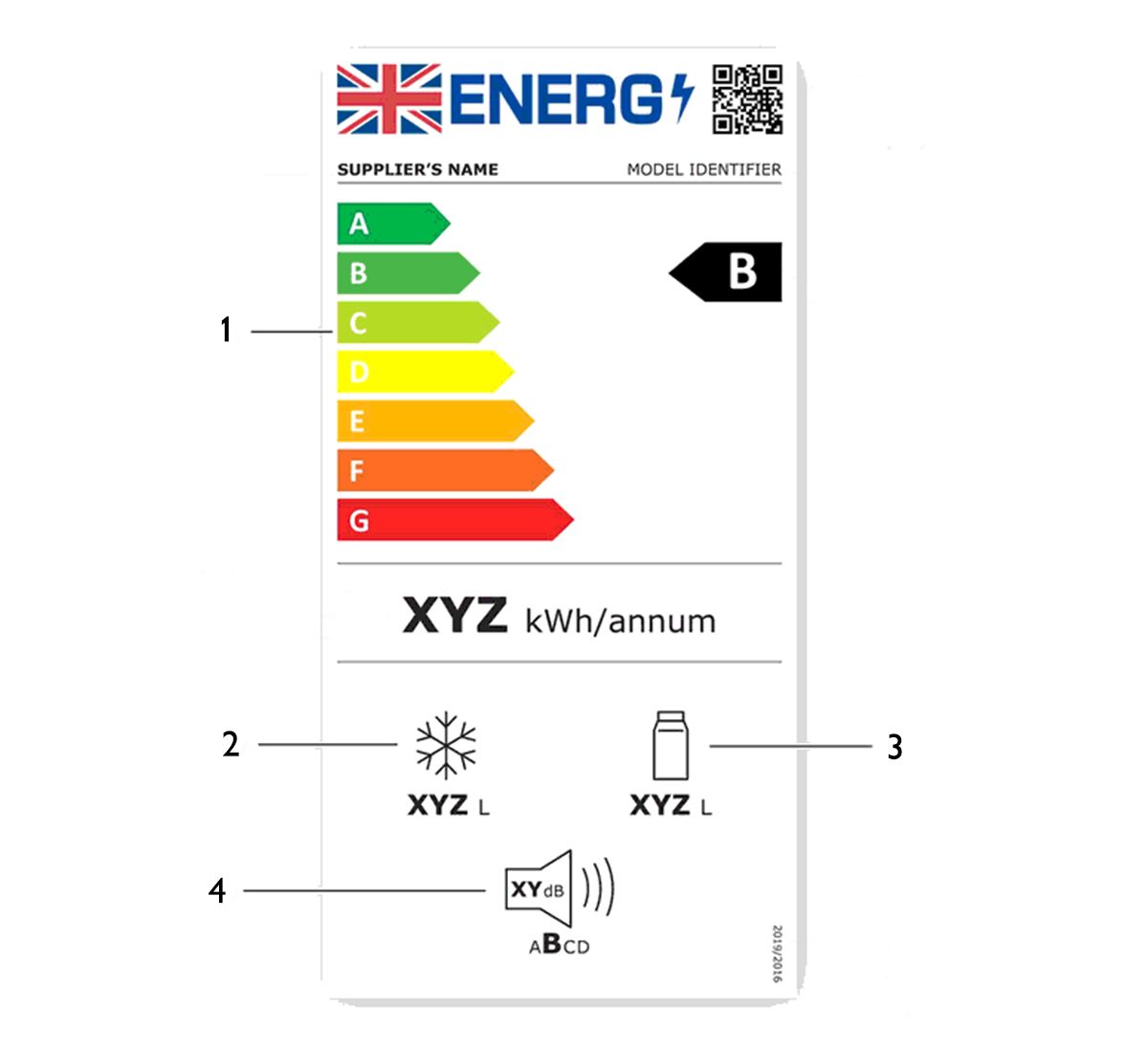
Energy efficient washing machines
Many of our washing machines come with energy efficiency features such as, lower temperatures, the ability to set the amount of energy your machine uses, as well as energy consumption tracking - so you know how much you have used. Investing in a washing machine with a higher maximum spin (1600rpm), will also ensure less time and energy is spent drying your clothes, towels and sheets.
How to read the washing machine energy label:
1 - Energy efficiency scale
2 - Energy consumption listed per 100 washes
3 - Added information on capacity and duration of 'Eco 40-60' programmes
4 - Water consumption listed (per litre)
5 - Noise emissions only include spinning (not washing) - but information on noise emission classes available
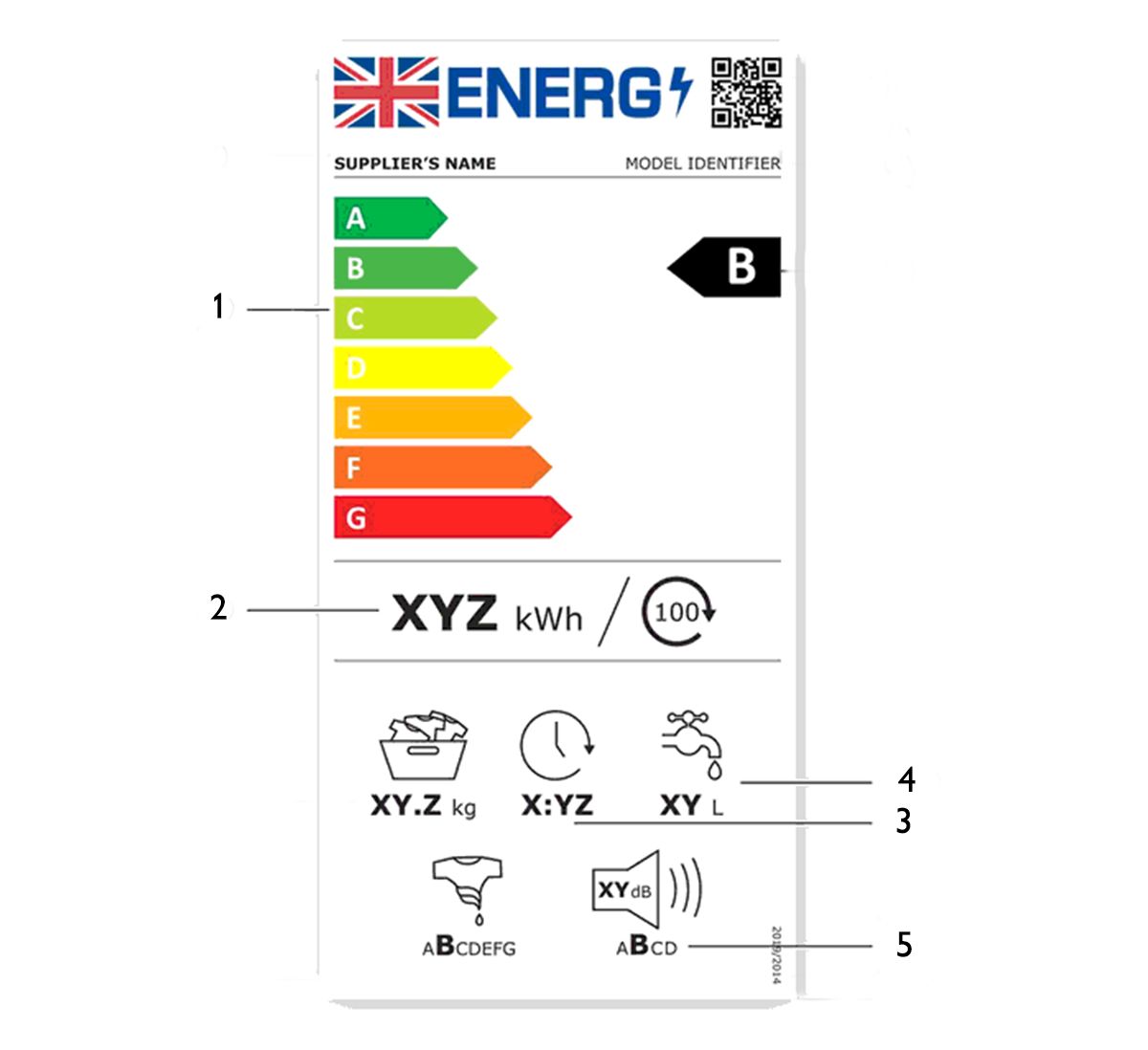
Energy efficient tumble dryers
On the labels you’ll see displayed symbols which show annual energy consumption (in kWh), the type of dryer, the cycle time (of the standard cotton program, with a full load, in minutes), its capacity (in kg) and the noise emission (in decibels).
The running cost of your tumble dryer will depend on how long the machine is drying for and how hard it has to work.
Investing in a heat pump condenser model may help you to use less energy too. This new technology re-circulates warm air used in the dryer rather than allowing it to escape – hot, humid air from the dryer is passed through a heat-pump for re-using. This method means that the dryer avoids the need for ducting and conserves much of its heat, using up to 50% less energy.
Laundry balls also help to reduce the drying time and reduce the creases in your clothes. Free from harsh chemicals and excess packaging, the reusable Dryer Dots not only help to reduce your energy bill, but they are environmentally friendly too.
Heated airers
Costing only pennies per hour, drying on a heated airer is more cost effective and kinder to your clothes than tumble drying.
Dehumidifiers
While these can’t match the speed of a tumble dryer, dehumidifiers can be used to dry your clothes in a way that is more cost-efficient and that provides additional benefits for the quality and condition of your home.
Put your damp laundry on a clothes airer and then place your dehumidifier nearby. While running, it will draw the moisture from your damp garments while releasing warm dry air back into the room.
Ad a dehumidifier steers clear of the high temperatures and tumbling action used by a tumble dryer, this method can be a lot kinder on your clothes and will extend their wearability.
Energy efficient washer dryers
Consider investing in a model with the highest spin speed you can afford, this will save you money in the long run as your laundry will have less moisture in it as it goes into the drying cycle, so it will dry faster. Use sensor drying (if available) rather than a timed cycle, that way you won't be using more energy than required.
For maximum efficiency when using a washing and drying cycle, remove some items from the drum after the wash, and do an additional second drying cycle - this is because the drying programme will have a smaller capacity than the washing programme. Also, clothes bundled into a ball will take a long time to dry, and that will increase the cost of drying. Fix this by loosening your clothes before drying them.
How to read the washer dryer energy label:
1 - Energy efficiency scale (IV washing and drying and washing)
2 / 3 - Energy consumption listed as per 100 washes (2 (washing and drying) and 3 (washing))
4 - A rated capacity listed for a wash & dry cycle as well as for a washing cycle
5 - Water consumption listed for a wash & dry cycle as well as for a washing cycle
6 - Noise emissions classes included for spinning
7 - Details included for duration of wash & dry cycle as well as for washing cycle
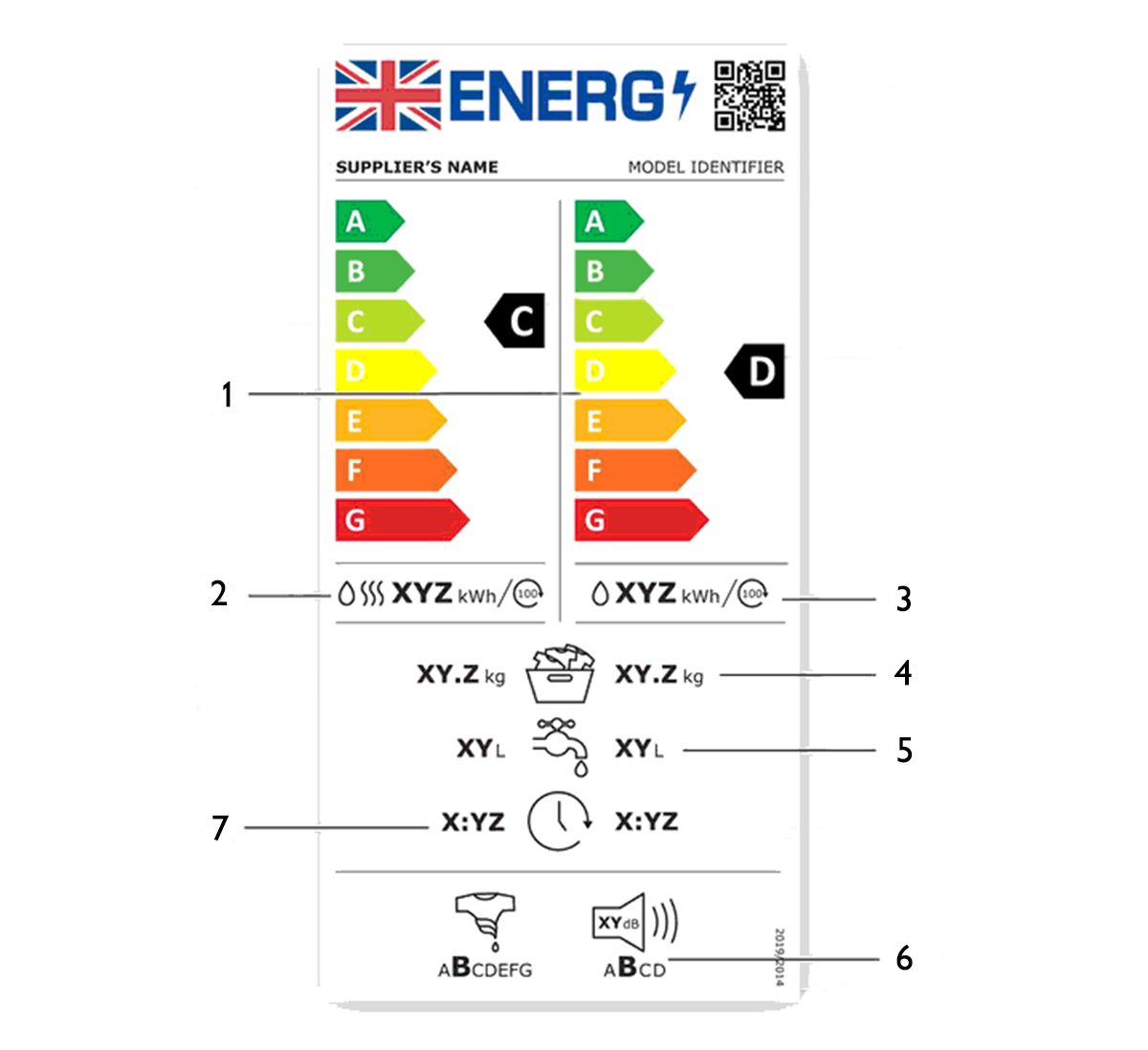
Energy efficient dishwashers
Dishwashers are becoming more energy and water efficient and the energy label provides a good indication of how much energy and water a model typically uses.
The energy efficiency of the dishwasher is displayed in kilowatt hours per year. The label also shows figures for annual water consumption (litres), drying efficiency (A to G rating), capacity (in place setting) and noise emission (decibels).
How to read the dishwasher energy label:
1 - Energy efficiency scale
2 - Energy consumption for an energy efficient ('Eco') setting listed as per 100 cycles
3 - Water consumption for an energy efficient ('Eco') setting listed in litres
4 - Duration of an energy efficient ('Eco') setting
5 - Icon for noise emissions and detail on noise emission class
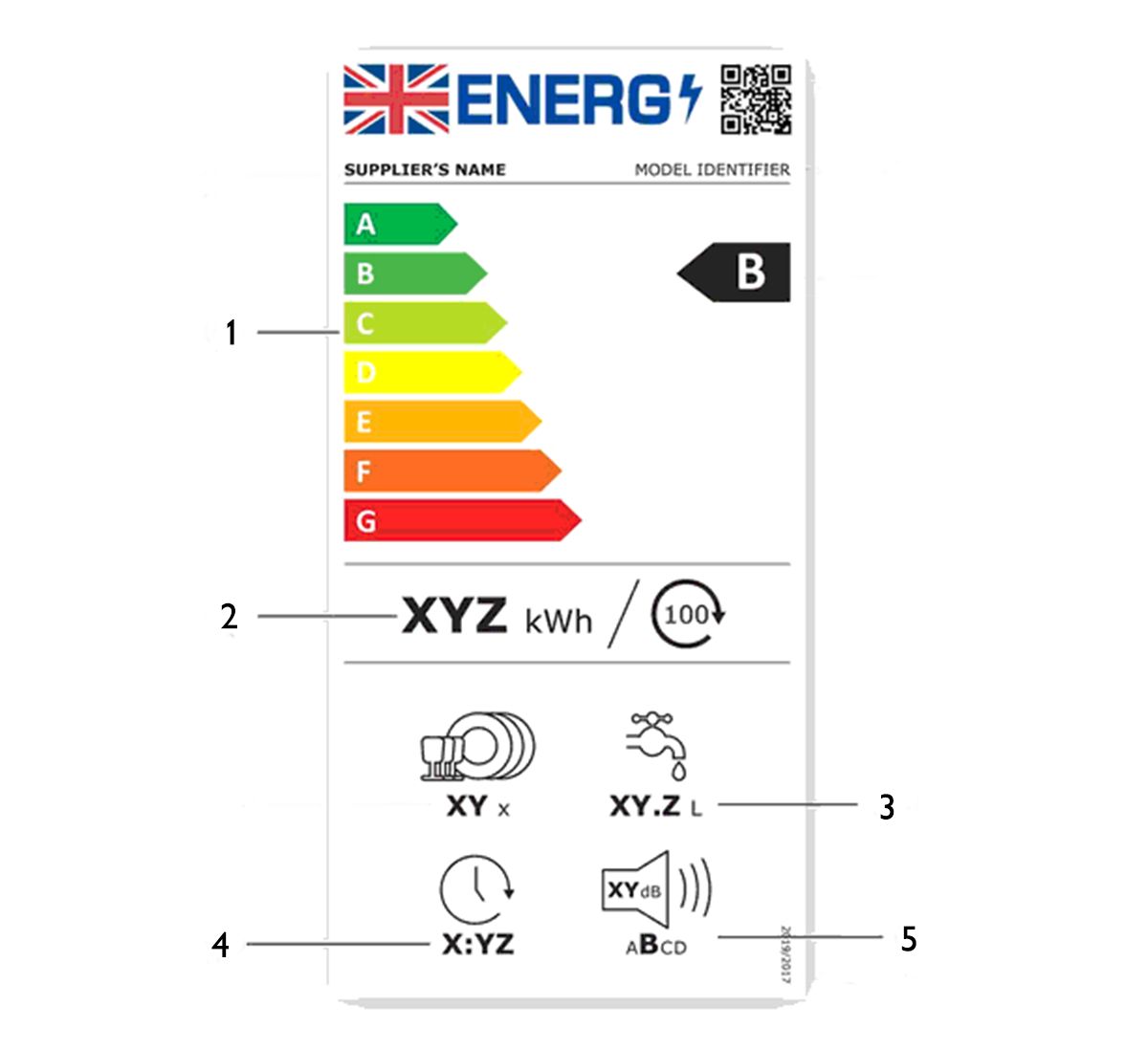
Energy efficient TVs
TV energy consumption still makes up a significant share of UK household energy bills.
As a general rule, the bigger the TV the more energy it is likely to use, with some screens more efficient than others.
If saving energy is the most important thing to you, then consider choosing a smaller TV — this can be just as important as choosing one with a good energy rating.
How to read the TV energy label
1 -Energy efficiency scale
2 / 3 - Energy consumption detailed per 1,000 hours of use for both Standard Dynamic Range (SDR) (2) and High Dynamic Range (HDR) (3)
4 - Screen size includes resolution level (in pixels)
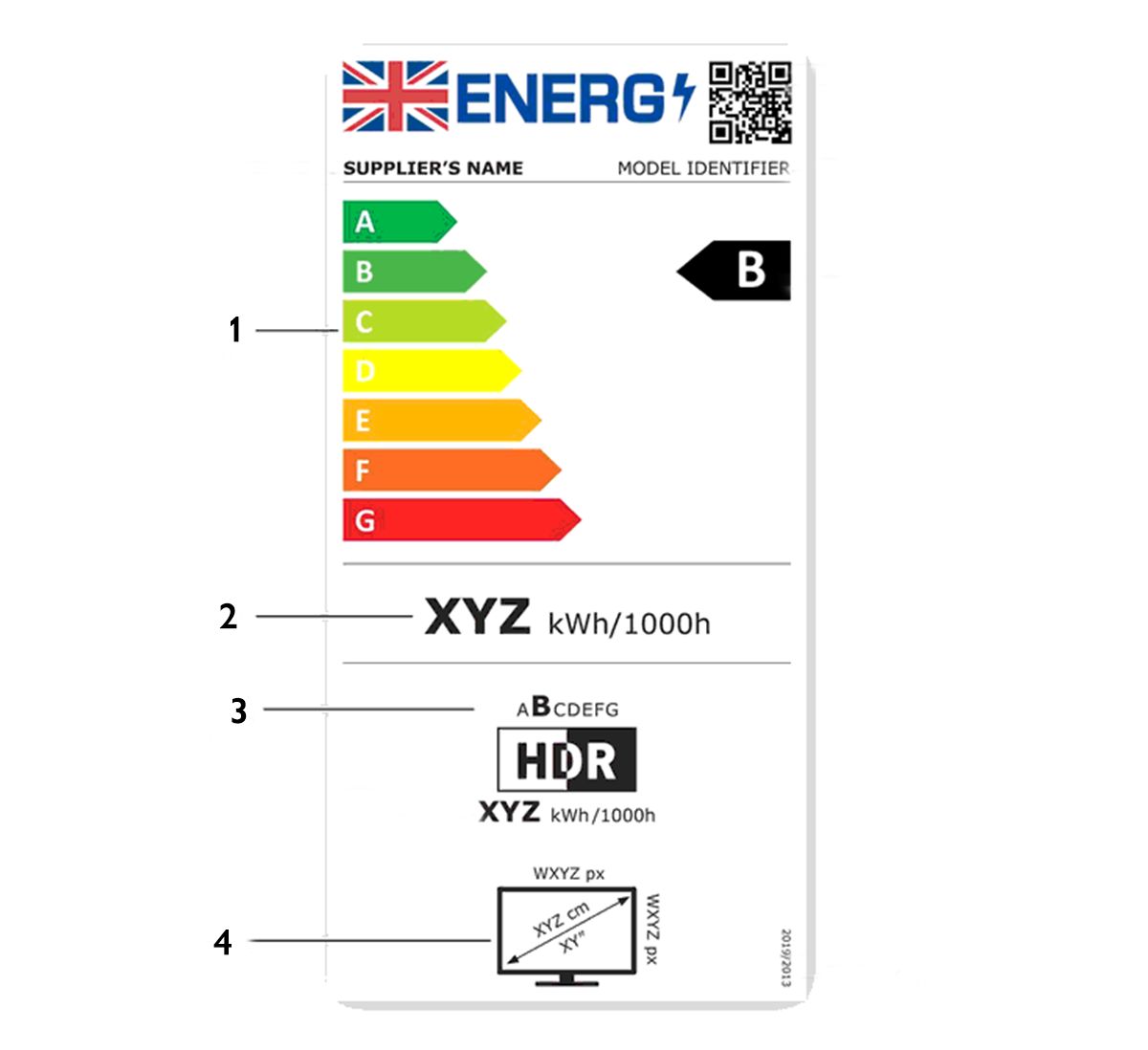
Electric ovens & hobs
Energy efficiency gradings for electric ovens are the responsibility of the appliance manufacturers and their work is monitored by Trading Standards.
Standard tests are carried out by heating a brick, and efficiency gradings of A+++ - G applied, with A+++ being the most efficient.
An energy label is available for each cavity of an integrated electric oven because of the difference in size.
Also featured on the label are pictograms which highlight selected performances and characteristics including energy source of the oven (electric), usable volume of the cavity in litres and the energy consumption per cycle for the heating function (s) of the cavity on a standard load expressed in kWh/cycle.
Although energy efficiency labels are currently unavailable for hobs, induction hobs feature cooking zones which automatically recognise the pan size for heat efficient cooking. They also have an energy consumption display so you know just how much energy you’re using.
Microwaves
Microwaves are a more efficent way of cooking as they heat the food rather than the air around it, using about 60-80% less energy than a conventional oven.
Air fryers
Air fryers are steadily becoming the most popular kitchen appliance and it's no surpise to see why. These worktop wonders are compact in size and cook very quickly, making them more energy efficent than a regular oven.
And as Air Fryers circulate hot air incredibly efficiently and create a 'fried finish' on foods with little to no oil, the results are healthier too!
Soup makers
Soup makers are an excellent way of rustling up a hearty broth, while saving you the cost of using a ring on your hob.
Slow cookers
Using just a little more energy than a traditional light bulb, you can leave your food to stew gently in a slow cooker while you get on with other things.
Electric blankets
Using an electric blanket works out significantly cheaper than leaving the central heating on through the night.
Electric heaters
It's more cost effective to heat up a single room or the rooms in use, rather than using central heating to heat up whole property. Oil-filled radiators are particularly economical to run.
Lighting & light bulbs
Halogen is being phased out in most light bulb types (excluding specialist bulbs), due to being energy inefficient. Make the switch from Halogen to LED bulbs, which are energy-efficient and long-lasting. All of our lights which require LED have a recommended bulb type on the product page. LED bulbs use up to 90% less energy than traditional bulb sources which significantly reduces waste and saves money. They are also proven to last longer than a traditional Halogen bulb, with a standard lifetime of up to 15,000 hours which is eight times longer than Halogen.
For more information on the different types of bulbs available, as well as tips on safety and disposal, read our Bulbs, Switches and Dimmers buying guide.
Energy efficient kettles & coffee machines
Currently there is no energy label to display the running costs of kettles and coffee machines.
Kettles use similar amounts of energy to boil up to a litre of water, yet they differ in energy efficiency.
Boiling hot water taps are becoming more popular — despite being more expensive to install, they have advantages over kettles. You only use the water you need and the tanks are well insulated to provide instant boiling water, rather than quickly losing heat like a kettle.
Generally, coffee machines use a small amount of energy which makes the cost of brewing a single espresso less than a penny. Many brands have incorporated their own energy-saving innovations to help cut costs even further. Like kettles, the most time-efficient coffee machines are more energy efficient.
Tip
To save energy and money, only boil only the amount of hot water you need, descale your kettle regularly (especially in hard water areas) and buy a kettle that features a low minimum fill level and over-boil time.
Telephones
Although landline telephones use a low amount of energy when they are not being used, they can gradually go on to consume a great deal of electricity over the year.
Some models use energy efficient power supplies via ECO Mode. This function decreases the transmitting power of the base station by up to 80%. Additionally, ECO Mode Plus is radiation-free and switches transmitting power off completely whenever your phone is in idle mode.
Energy efficient wine storage
Wine cabinets do cost slightly more than a regular refrigerator to run. Storing lots of bottles will help maintain the desired temperature as opposed to the appliance being left half empty.
Don’t position your wine cabinet in direct sunlight as this could cause the interior to heat up and drive up the energy consumption.
How to read the wine storage energy label:
1 - Energy efficiency scale
2 - Icon for wine bottle capacity
3 - Icon for noise emissions and more details of noise emission classes
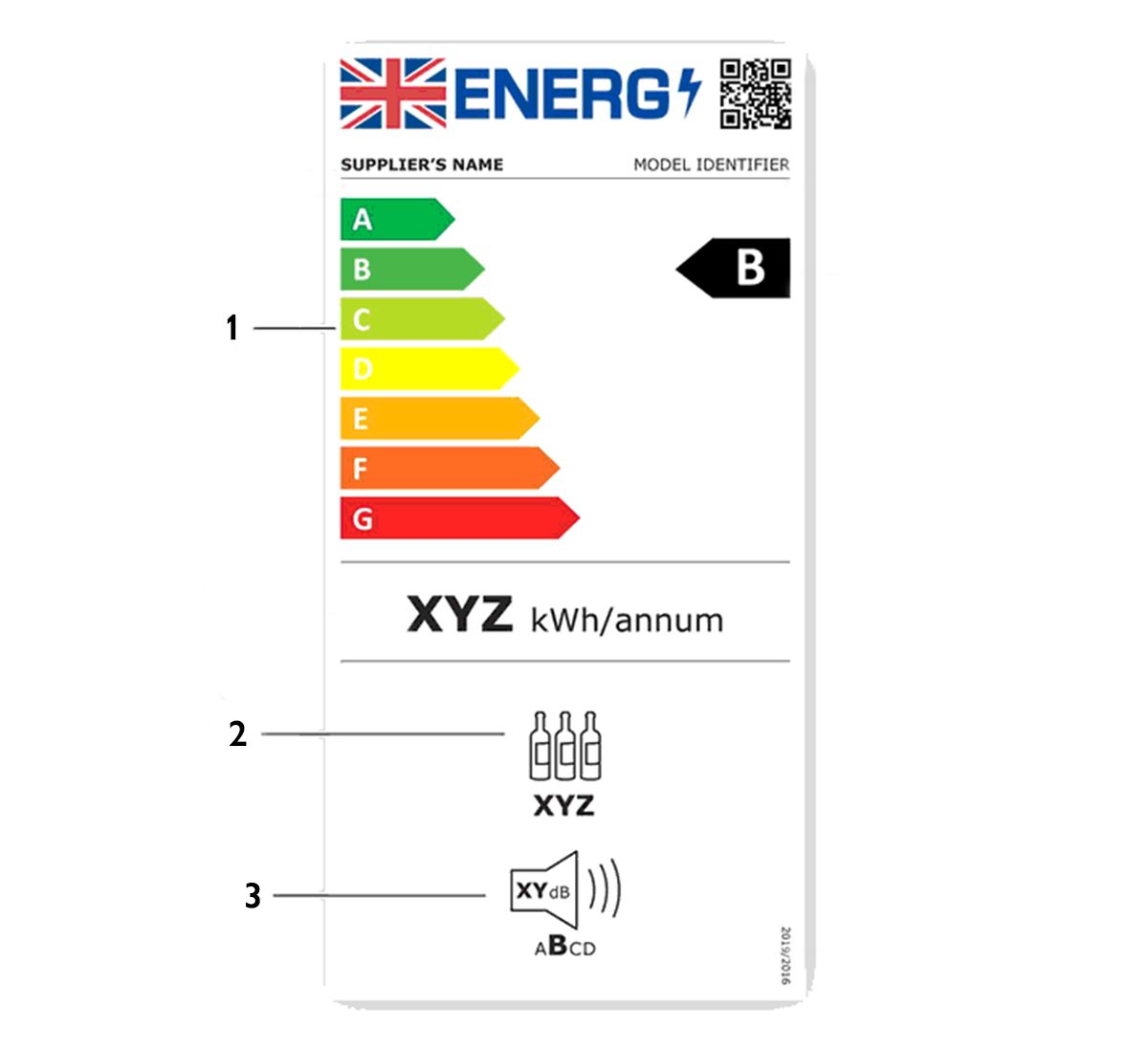
Batteries
Rechargeable batteries can be reused hundreds of times, saving you a lot of money in the long term
Recycling
The UK’s waste electrical and electronic equipment (WEEE) regulation has allowed members of the public to deposit old electrical and electronic items, free of charge.
These regulations also require those who manufacture, import or produce one tonne of batteries, or those who place products containing batteries onto the UK market, to be responsible for the collection, treatment and recycling of the waste batteries. To find out more, read our guide on electronic recycling.
If you’re replacing a home appliance and want to find out about disposal of your old appliance, visit our home appliances installation & disposal page.
CFL and LED bulbs should be recycled at your nearest recycling bank, which will be found at www.recycle-more.co.uk
Quiet Mark
During the night off-peak energy prices are reduced, but everyday appliances like your washing machine can be too noisy, disturbing you and possibly your neighbours.
If you're looking for an appliance that can save you money and work discreetly without disrupting the tranquillity of your home, just look out for the Quiet Mark. We sell a range of appliances that have been awarded with this certification, including products from AEG, Miele, Dyson, KitchenAid and Bose.

